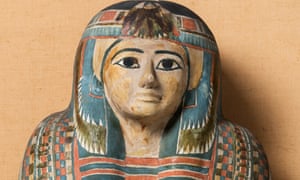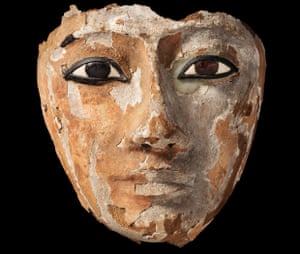The lure of ancient Egypt is a way to revitalise faded industrial towns
With local authority budgets being slashed, how can regional arts institutions survive? Investing in mummies is one solution

Museums teach us to dream. Since the Victorian age it's been Egyptian mummies – matched only by dinosaurs – that have captivated children. Being taken to see the mummies is a rite of passage, and one accessible across the country, not just to those in London who have the British Museum on their doorstep. But local authority culture budgets are being slashed, so how can regional arts institutions survive? What should they do about the pressure to return looted objects? And how do they show their relevance to modern audiences?
I have been exploring the history of three northern Egyptian museums, which have four remarkable Victorian women at the heart of their story. For those looking for entries for one of those currently popular anthologies of plucky rebel ladies from history, they all fit the bill.
They are Amelia Edwards, who founded the Egypt Exploration Fund (EEF) and funded the first university chair of Egyptology at University College London in 1892; and three northern mill family heiresses, who put the freedom afforded by their wealth into travelling to Egypt to bring back treasures for their local towns. Amelia Oldroyd used funds from Dewsbury's branch of the EEF to bring back mummies and grave goods including a rare intact papyrus mummy covering or cartonnage, housed eventually in the Dewsbury Museum; Annie Barlow, whose family fortune came from processing Egyptian cotton in Bolton mills, did the same for her city; while Marianne Brocklehurst, the daughter of silk manufacturers, built the West Park Museum in her home town of Macclesfield to house the mummy cases and artefacts she brought back.
There's a strong claim that Edwards and Brocklehurst were doubly pioneering, as lesbian women – Brocklehurst travelling on her expeditions down the Nile with her companion, Mary Booth – at a time when women were still struggling to gain status outside the home. Brocklehurst's diary sketches are some of the best contemporary records of dig sites before they were disturbed.

But Dewsbury Museum was shut in 2016 along with others by Kirklees council. And Oldroyd's collection is now in the Bagshaw Museum in Batley which has no expert curators on staff and short opening hours, although it has invested in a beautiful tomb display. Brocklehurst's purpose-built museum is also currently shut as Macclesfield merges its Egyptology displays to a central site, though there are plans for a major refurbishment.
And there are serious questions about how to present the treasure, mummies in particular. Both Edwards' and Brocklehurst's diaries reveal a cavalier land grab of acquisition as rival museums such as the Louvre and the British Museum, and private collectors jostled with each other and colluded with corrupt local officials to smuggle out what they could not obtain officially. "Once we were safely boxed up," wrote Brocklehurst, "we devoutly hoped it, the case only, might escape the prying fingers of the dreaded police who are waiting for us at Cairo and Alexandria, everywhere. And we feared lest the cook in particular, doubtless acquainted with the peculiar mummy bouquet, might sniff him out and bring us all grief." They ended up discarding the body of a 15-year-old temple girl, possibly in the Nile, but kept the beautiful mummy case. It sits in a cabinet in the Old Sunday School Museum in Macclesfield with no clue as to its grisly provenance. Next to it a cabinet contains objects from Brocklehurst's study, including two mummified unlabelled human hands, in a glass cabinet, like souvenirs.
"There is a key word in every single diary that you read from," says Egyptian-born archaeologist Heba Abd el Gawad, who co-curated the Beyond Beauty exhibition in London, drawn from these collections, two years ago. She believes the diaries reveal women who knew they were on thin moral ground. "It's the word 'rescue'. They are there to rescue the artefacts from the Egyptians." El Gawad believes that while repatriation isn't always the end goal, "part of the job of museums is to bring social justice, not only to the visitors, not only to allow everyone to enjoy a public museum, but to bring social justice to the people of the past. Museums should never be neutral."
Bolton Museum shows how it can be done. Annie Barlow herself is put into context in a refurbished gallery labelled "Bolton's Egypt" which features a photograph of her in the 1930s with Mahatma Gandhi. Daylight floods into the main gallery, where the objects are part of a celebration of the real life and landscape of ancient Egypt. Only then do visitors enter a reconstruction of the tomb of King Thutmoses III, housing a real mummy, and signage acknowledging the sensitivity of displaying human remains.
Watching crowds of children pouring in to Bolton Museum, some almost overwhelmed with their passion for the Ancient Egyptians, is a reminder that honest, modern presentation and far-sighted, cultural investment can revitalise towns that have lost their industrial past with a very real, modern pride.
• Samira Ahmed's documentary The Victorian Queens of Ancient Egypt is on BBC Radio 3 on Sunday 3 February at 6.45pm
 https://www.theguardian.com/commentisfree/2019/jan/21/lure-ancient-egypt-revitalise-industrial-towns-mummies
https://www.theguardian.com/commentisfree/2019/jan/21/lure-ancient-egypt-revitalise-industrial-towns-mummies
--
Sent from my Linux system.

View all comments >